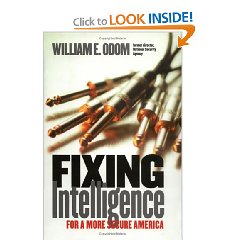Among the many important points that he makes, I especially agree with his pointing out the need to fully integrate the management of inputs and outputs within each of the major collection disciplines–as he notes, disconnecting the building of satellites, or aerial imagery vehicles, or unmanned aerial drones, from the actual needs of the end-user and the actual responsibility to produce imagery intelligence, leads to precisely what the National Imagery and Mapping Agency Commission Report of December 1999 noted as the major shortfall in national intelligence–close to a trillion spent on secret satellite collection, and nothing spent on tasking, processing, exploitation, and dissemination (TPED). The author specifically identifies $6 billion in savings being achievable from the NRO budget over five years–savings that could be applied to enhancing analysis, creating competent clandestine collection capabilities, establishing global open source collection activities in each of the theaters, and creating a new national counterintelligence and homeland security intelligence program.
In passing, on page 146 the author “blows the whistle” on the deception imposed on the public by the CIA's clandestine service, which was actually largely incapable in Afghanistan in 2001, and was saved secretly by Russian sources & methods. My own sources tell me that there are some very ugly stories yet to be made public, and the author–whose access and credibility cannot be questioned–is helpful in sharing what he knows on this–America needs a competent clandestine service, not one that pretends that clerks mixed with cowboys, all working from official installations, are anything other than a joke.
The author demonstrates a very deep understanding of the shortfalls of the intelligence bureaucracy, the intelligence culture, intelligence leadership, and the policymakers that fail to direct or exploit intelligence on behalf of the Nation.
There are a few weaknesses in this book, costing the author one star, and they are mentioned to correct the record, as it were–in no way do these weaknesses reduce the value of the book or the importance of the author's views when we finally get around to fixing U.S. intelligence.
First, he is limited in his understanding of the importance of Global Coverage of lower tier issues that can be addessed by open source intelligence (OSINT), including commercial imagery and Russian military combat charts; and he is equally limited in his understanding of both OSINT, and the urgency of finding new means of supporting multilateral peacekeeping operations that mix both government militaries and government law enforcement missions with non-governmental and other private sector actors.
Second, he continues to have a modest obsession with technical solutions, and neglects to properly address the shortfalls in inter-agency information sharing and processing that could be partially resolved by enhancing the National Security Agency's considerable computational power to that it can become an all-source processing manager–at the same time, the author seriously over-states the availability of both bandwidth and tactical processing, while under-stating the enormous flood of unclassified information, including geospatial information, that must be processed if commanders are to be able to understand their combat environments in near real time.
Lastly, the author comes close to spasms of fury when referring to the Central Intelligence Agency, and to a lesser extent, to the Defense Intelligence Agency and the Department of State. His anger and disdain with regard to these organizations are recurring He is clear in his view that the “all source analyst” cannot and should not be centralized, that analysts must work for the end-users, and that both CIA and DIA should be abolished. While I disagree with this viewpoint, it is a mature informed viewpoint that CIA and DIA managers must address–they ignore General Odom's concerns at their peril.
The book is based on the 1997 study by the National Institute for Public Policy that was chaired by the author and included such other thoughtful executives as LtGen James Clapper, today the head of the National Imagery and Mapping Agency. The author has made his own statement in this book, and it is perhaps the most practical and the most focused on the public statements on the need for intelligence reform. This book has been added to the OSS.NET listing of the top books on intelligence reform.





